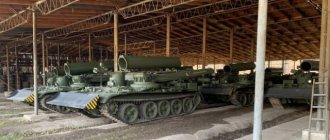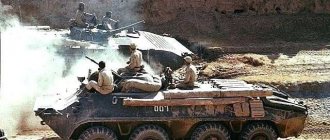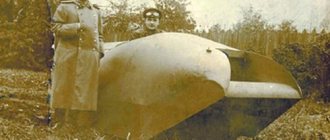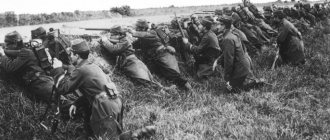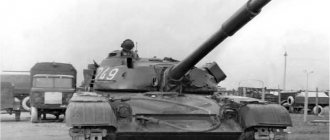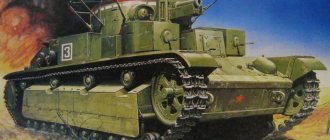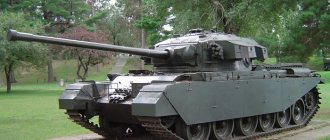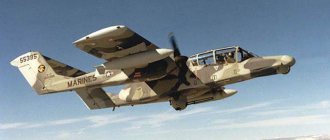The use of tanks and aircraft during the Afghan war of 1979-1989.
Tanks and other heavy equipment in Afghanistan
From the beginning to the end of the fighting in Afghanistan, from 1979 to 1989, tanks were used only by government troops and Soviet troops as part of the 40th Army. They were reinforced by motorized rifle (parachute, air assault) battalions/companies and operated as part of platoons (sometimes companies).
The T-55 medium tank is the basis of the Soviet group in Afghanistan
The bulk of Soviet tanks used in that war were T-55 and T-62 of various modifications. With all the undeniable advantages of these unpretentious and reliable machines, the war in Afghanistan also revealed their relatively weak points, which manifested themselves in the specific conditions of the theater of military operations:
- The tank gun and the coaxial machine gun had an elevation angle of only 30 degrees, so it was impossible to fire from them at enemies located on a hill.
- Tanks designed primarily for the “European” theater of operations and offensive tactics in the context of confrontation with similar enemy combat vehicles turned out to be poorly protected against mines.
- In high altitude and dusty conditions, the tanks had constant problems with the power plant and transmission.
Tactics for using tanks
Blocking and combing the area
Tanks operated as part of motorized rifle units, and sometimes independently. Firing positions were occupied by platoons, blocking with fire the enemy's exit routes from the blocked area. In all cases, the tanks were covered by small arms and artillery fire (mostly mortars). Fire and maneuver control was carried out by the commander of the tank unit, located at the command and observation post of the motorized rifle battalion or one of its companies.
In counter-guerrilla operations, tanks cover motorized riflemen with armor and destroy the most important targets with fire and tracks. Classic tactics in this case (operation in Helmand province, 1984):
The parachute battalion walks in two parallel routes, combing the area, the tanks are at the head of the column, ahead of them are sappers, covered by troops from tank armor. The discovered enemy is immediately destroyed by the fire of tank cannons and machine guns, and paratroopers conduct continuous combing between routes.
Using this tactic, the battalion was completely cleared of the enemy in 3 days, and there were no losses in personnel or military equipment, although up to forty RPG shots were fired at the tanks alone.
Tanks in assault groups
To destroy enemy entrenched in fortresses and other strong structures, tanks were often used as part of assault groups. In addition to destroying the enemy by fire, they often destroyed buildings with a blow from the hull, and punched passages in barricades and walls.
Tanks accompanying columns and protecting objects
Tank units were used to escort columns and protect communications. In the first case, 1-2 tanks with mine trawls operated as part of a movement support detachment, the rest were evenly distributed throughout the column. When the enemy attacked, the tanks drove off the road and covered with fire the cars that were driving through the dangerous area at high speed.
Tanks were also included in the outposts guarding communications, that is, they were involved in the protection of various objects. In this role they were used as long-range and maneuverable fire weapons.
Soviet medium tank T-55
Losses of Soviet tanks in Afghanistan (1979-1989)
It can be especially noted (especially when compared with other military conflicts of the late 20th century) that during the fighting in Afghanistan, Soviet tanks had relatively low combat losses.
In general, for the 40th Army the ratio of failures due to technical reasons and combat damage to armored vehicles was 20 to 1 . Combat losses occurred mainly from mines and land mines, while more than 50% of the damaged equipment required major repairs or could not be restored.
However, the Soviet command reacted quite quickly, so soon the combat experience gained by the troops was used in the development of new ways to use tanks in battle and modernization of existing models of armored vehicles. In particular, modernized T-55M1 and T-62D tanks with improved mine resistance and enhanced armor protection were quickly created, which immediately began to arrive in the 40th Army. Subsequently, some design solutions that showed advantages during the Afghan war were used in new modifications of the T-72 and T-80 tanks.
Soviet aviation in Afghanistan
The main tasks facing Soviet military aviation in Afghanistan were conducting reconnaissance, destroying enemy ground forces, and transporting troops and cargo.
The Mi-24 helicopter is a real flying tank of the Soviet group
By the beginning of 1980, the Soviet aviation group in Afghanistan was represented by the 34th mixed air corps (later reorganized into the 40th Army Air Force) and consisted of two air regiments and four separate squadrons. They consisted of 52 Su-17 and MiG-21 aircraft.
In the summer of 1984, the 40th Army Air Force included three MiG-23MLD squadrons, which replaced the MiG-21, a three-squadron Su-25 attack air regiment, two Su-17MZ squadrons, a separate Su-17MZR squadron (reconnaissance aircraft), a mixed transport regiment and helicopter units (Mi-8, Mi-24).
Su-24 front-line bombers and Tu-16, Tu-22M2 and Tu-22M3 long-range aircraft operated from the territory of the USSR.
Clashes with Pakistani and Iranian air forces
The first air opponents of Soviet fighters in Afghanistan can be considered helicopters from Iran and Pakistan, which conducted reconnaissance over the border areas. Such cases were recorded quite often, and more than once it was noticed how foreign helicopters landed on Afghan territory. KHAD counterintelligence also indicated specific locations for such landings, right up to Panjshir itself. But neither the Afghan air defense nor the aviation of the 40th Army was able to stop these “overruns.” Although Soviet fighters were given this task more than once, it was considered secondary - they had enough work on ground targets.
The first case of a combat collision between Soviet 40th Army aviation and aircraft from countries neighboring Afghanistan involved an Iranian Air Force F-4 fighter-bomber. In April 1982, a Soviet helicopter landing force was mistakenly landed on Iranian territory. A pair of F-4s that arrived at the landing area destroyed one helicopter on the ground and drove the landing An-30 out of their airspace. However, at that time there were no special complaints against the Iranians.
Su-25 attack aircraft
The first air battle was recorded on May 17, 1986. In the area of the Afghan-Pakistani border, a Pakistani Air Force F-16 shot down an Afghan Su-22. Pakistani aircraft repeatedly attempted to intercept Afghan aircraft in the area of the common border, which resulted in the loss of one F-16 over Afghan territory on April 29, 1987.
On August 4, 1987, an incident occurred that became widely known - a Su-25 attack aircraft of the deputy commander of the 40th Army Air Force, Colonel A. Rutsky, who was coordinating an attack on targets on the ground, not far (6 km) from the border with Pakistan, was shot down by a missile from a Pakistani fighter.
Still, air battles during the Afghan war were an isolated thing. Soviet aviation suffered the main losses from fire from the ground, where the greatest danger was posed by man-portable anti-aircraft missile systems supplied to the Mujahideen by the Americans and Chinese.
Source: based on materials from afgan1979-1989.narod.ru
Firearms.
Automatic weapons include: AK-74 (Kalashnikov assault rifle), AK-74u (used by paratroopers, since space in armored personnel carriers was limited and small weapons were required).
Of the sniper rifles, only the SVD can be distinguished, since there were no more rifles in service at that time, and the VSS Vintorez and AS VAL appeared a year before the end of the war.
Just as in the case of sniper rifles, only RPK - Kalashnikov light machine gun and PK - Kalashnikov machine gun can be classified as light machine guns.
With a detachment of heavy machine guns, everything is better; here there are such magnificent examples as: NSV “Utes”, DShK.
History of the event
The confrontation between the official government and the Mujahideen began in 1973. Representatives of the Afghan Republic appealed to the Presidium of the USSR with a request for help. For 6 years, Brezhnev refused, considering the Army’s participation in the civil war in Afghanistan inappropriate.
In 1978, power in the Republic passed to the PDPA. The rule of a socialist-minded government suited the USSR, as it indicated the expansion of the influence of leftist ideology. Therefore, when the PDPA turned to the Soviet Union for help, the government of the country decided to provide it. Thus, on December 13, soldiers of the Soviet Army were transferred to Afghanistan.
Participation in the conflict lasted 10 years. The last soldier left the republic on February 15, 1989. Losses amounted to 13.8 thousand military personnel, 49.9 thousand were wounded, and 6.7 thousand military personnel were disabled.
The need for the participation of internationalist soldiers in resolving an internal conflict is not justified. After the withdrawal of the USSR Armed Forces, the PDPA existed for another 3 years. Then power again passed into the hands of the Mujahideen. The Soviet Union began strengthening its borders, and shelling and infiltration attempts by Islamists continued with renewed vigor.
Armor
From the very first weeks of combat operations, the insufficient protection of infantry fighting vehicles, armored personnel carriers and even tanks became obvious. The soldiers themselves improved the reservation. Metal sheets were welded onto the roofs of the armored personnel carriers. The same sheets were welded to the bottom to protect against mines. Also, brackets were often welded onto the armored personnel carrier, into which boxes or sandbags were inserted.
However, the additional sheets of metal, although they saved from bullets and shrapnel, helped little against shaped charges. If such a charge hit the weakly armored side of an infantry fighting vehicle in the landing zone, everyone inside died. The soldiers even interpreted the BMP as a “mass grave of the infantry” and preferred to ride on the roof, hiding behind sandbags.
Andrey Zaets in the book “Armored Vehicles in Afghanistan” describes the hit of a cumulative projectile: “A grenade stuck into the starboard side, just above the ammunition stowage. Inside the car, everything was filled with smoke; a grenade, having gnawed a hole in the armor at the heels, spewed a stream of molten metal inside. The floor of the car vibrated under our feet, and the pressure pushed back the top hatches.”
To protect against shaped charges, which burn through the armor upon collision with it, special grilles and screens were welded onto infantry fighting vehicles and tanks. The calculation was that the projectile, colliding with such a screen, would detonate before it touched the armor; the cumulative jet would dissipate and would not cause harm.
To increase the thickness of the armor, tank turrets were wrapped with caterpillar tracks. The same tracks were attached to the sides.[C-BLOCK]
Angle of attack
Often the Mujahideen set up ambushes in mountain gorges and attacked columns of Soviet troops higher up the slope. The usual tactic was to knock out the first and last vehicles in the column, thereby locking the retreat route, and continue to fire at the immobilized Soviet forces. The first thing that was noted in such battles was the insufficient elevation angle of the gun on armored personnel carriers and infantry combat vehicles. While the command was developing new models of armored personnel carriers and infantry fighting vehicles, the combat units were solving this issue by installing anti-aircraft guns in the bodies of trucks.
Since the Mujahideen did not have aviation, anti-aircraft machine guns were used to cover columns of equipment. The twin 23-mm anti-aircraft gun was removed from the platform, a frame with protective armor plates was welded to it and placed in the back of a truck. Publicist Gennady Dolzhikov writes that sandbags were placed at the bottom of the body to protect against explosions, and the sides were covered with body armor. There were also options for installing anti-aircraft guns on armored personnel carriers.
Such a weapon could fire at a very large angle up the slope and quickly rotate 360 degrees, changing the sector of fire. The truck cabin was also protected with metal plates. For the same purpose of defeating an enemy entrenched at a height, the Shilka self-propelled anti-aircraft gun was used, from which the radars were removed and the ammunition load was increased.
Another invention was the installation of NURS (unguided rocket) units in truck bodies and on the roofs of armored personnel carriers. The drive for the guidance system was also used from a helicopter, but the frame had to be made by hand. The column on the march was usually covered by trucks of both types - NURS and ZU. Another option was to install the Cornflower mortar.
The pinnacle of evolution was the Ural trucks, in the body of which the body of the BRDM (armored reconnaissance patrol vehicle) was installed, to the turret of which the NURS was attached. Thus, fire could be fired both from a standard BRDM machine gun and from a rocket launcher. In the absence of missile pods and anti-aircraft installations, automatic grenade launchers and heavy machine guns were installed.
